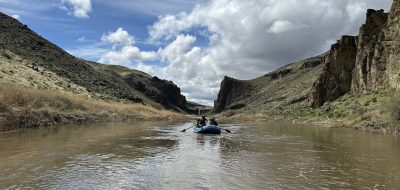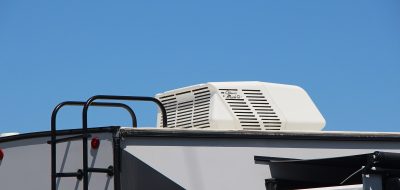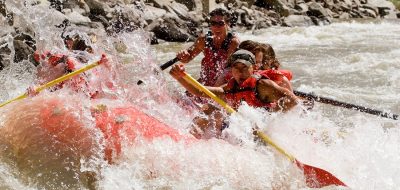By Bob Difley
Spring suddenly blossomed into an early indication of the summer to come, with temps soaring this weekend in Northern California to the mid-eighties along the coast, and high 90s inland. Desert temps are driving the last of the snowbirds onto their northerly migration as temps soar over 105 degrees.
When that kind of weather hits suddenly, without much time to acclimate, many RVers fire up their air-conditioners and stay inside, hoping the heat will not last for too many days. Boondockers are different, though, heading up in altitude rather than in latitude because of what is known in weather circles as “lapse rate,” the increase or decrease in temperature with the change of altitude.
To complicate things, the rate of change varies with the moisture in the air–the humidity, just as the temperature spread between day and night at the same altitude varies with the humidity. You’ve all noticed that in humid areas, the mid-west and south for instance, in summer the variance between day and night is minimal. Remember trying to sleep after a 90-degree day when it cooled off to only 80 degrees overnight. Or how nice it was in the desert after a 90-degree day to have the night cool down into the 60s.
In dealing with altitude, though, the amount of change for desert–or dry–air is called the “dry adiabatic lapse rate” and is equivalent to 5.4 degrees fahrenheit (3 degrees celsius) for every thousand feet of altitude. What that means for boondockers is that instead of (1) having to run the noisy smelly generator for hours in order to operate the air-conditioner long enough to cool–and keep cool–your RV’s interior, and (2) having to stay inside where the air-conditioning is just to be comfortable, we just head up. Staying clositered in a tiny house-on-wheels instead of being outside is not a consideration in my book.
One April a few years ago we had just left our winter digs along the Colorado River in Arizona and were heading east on US 60 with the intent of visiting the fine Desert Caballeros Western Museum in Wickenburg. Though we got a fairly early start, by noon when we pulled under the shade of a cottonwood tree for lunch, the thermometer had registered 100 degrees. We shelved the museum idea with visions of the Ponderosa pine forests surrounding Prescott, so we made a left turn and within an hour and a half had climbed from a hot desert elevation below 2,000 feet to the cool forests of Prescott at 5,300 feet, and a decrease in temperature of more than 20 degrees. It felt positively cool.
So now, when conditions get too hot, we head uphill. Not only does the change in altitude kick in our natural air-conditioning system, but as a boondocker we are not restricted by the positioning of a campsite pad, and can angle our rig so that we are broadside to the prevailing breezes. We then open all the windows on both sides, and let the natural cooling breezes do their work, while we go out and enjoy a hike, the trees, birdlife . . .
Oh, by the way, this boondocker’s air-conditioning system doesn’t work so well in those humid areas I mentioned, for two reasons. One, the “wet adiabatic lapse rate” for moist, humid air, is only half that of dry air areas–a mere 2.7 degrees for every thousand feet of altitude. And in the mid-west and south there just aren’t that many mountains where you can climb up a few thousand feet in an hour and a half.
Note of (hopefully) interest: I am working on an ebook on boondocking. When it’s ready I will let you know here in my blog.









Pingback: RV Weekly Round-Up (May 16-22, 2009) : blog.rv.net
Bob Difley
to airconditioning – I knew someone would mention that, and fancy that, it was someone named “airconditioning.”
I think there is a difference between driving a motorhome and driving a car regarding airconditioning. I drive with the air on in the car, it has been proven that your mpg with the windows closed and the air on is better than not using the air and opening all the windows, In addition to that, it is much quieter and less turbulent. In a motorhome–mine at least–the air conditioner is in the middle and the front driver’s compartment never does cool down to comfortable airconditioning temperature, but stay warm–maybe not hot–which with the windows closed is oppressive to me.
But the main raison d’etrre for this blog was not the driving but the camping. And I’m sure that iff you were car camping you wouldn’t sit in the car with the air on. Sometimes, though, when excessively hot, I would turn on the air after the sun went down to bring the inside temperature down to the outside, more comfortable, temperature. Thanks for your comments.
airconditioning
Rarely would you see cars today running without the car air conditioner on. Unless of course you are situated in cooler climate countries, using air conditioners can do more than just cool you off.
Bob Difley
Brian – It’s thanks to you and your great and enthusiastic interview style that put that video over 1,300 views. That and the fact that when most people see boath “beauty” and “Bob Difley” in the video title, they mistakenly thing of porn.
Bob Difley
Hi Ian – Thanks for the comments. I wonder, though, that when the snowbirds return from their escape from the snow when the weather starts to get hot, are they not snowbirds on the return flight? Maybe we should call them cactus birds. Bob
Bob Difley
Ron – How do you get your sailboat from the Puget Sound up into the mountains?
Brian Brawdy
Congrats on your ebook Bob. As an FYI, your Video on The Beauty of Boondocking with Bob Difley is now number 2 with over 1,300 views. See http://blog.rv.net/videos/
Ian McKee
Don’t argue with your thesis but I do with your use of language. A snowbird is one who flees the snow for warmer climes, not the reverse. As an AZ resident, I can attest to that. Your usage debases and fuzzes up meaning to everyone’s detriment.
On your point, altitude is great for cool but all desirable places are not on high. Last summer we didn’t hit cool until we got to Canada!
photoian
Ron Butler
Bob,
Good information. Those of us in the Puget Sound area always know that when we get out 5 – 14 days of summer with temps in the high 90’s, we head for the hills!! We are real wimps here!
I’m assuming that by staying at altitude in Colorado in the middle of July through Aug. we will a little more comfortable!
Take care,
Ron
John Shelton
As I started reading your article, I thought I was going to see a paragraph or so about swamp coolers. Instead, you put some statistics to a phenomenon that most of us are at least vaguely familiar with. Now we know why it feels so nice on the mountaintop in summer.
trivia question: Why do they call an evaporative cooler a “swamp cooler” when they don’t even work in a swamp environment? Strange, isn’t it? We park in the driveway and drive on the parkway; and a swamp cooler only works in the desert. What a life!
Bob Difley
Lyle – Water and wind combined are a great air-conditioner, without all the machinery. Maybe we are old school, but when it’s hot, I have a hard time closing all the windows while driving andturning on the roof air. My wife and I used to carry small spray bottles, misters that gardeners use to spray plants, and mist ourselves as the wind from driving cooled us. Another factor is allowing your body to acclimatize to the temperature, following which you will adjust to the change (increase) in temperature. Thanks for the comment.
Bob Difley
Fred – Three times that I can remember we headed up into higher country as it got hotter in the lowlands and we got a dusting of snow. Once from the Sacramento Valley up to Lake Tahoe, another up to Grover Hot Springs State Park in the Sierras of California, and the third from the Arizona desert along the Colorado River to the Grand Canyon–and that was mid-April.
Lyle Frevert
When we travelled across the desert, before we had air conditioning, we used water and hand towels. We wiped our faces, necks, arms and legs with the wet towels and let the wind blow across our wet skin. We became very well cooled.
Fred
Bob, you found one of my science papers from Forestry School at NAU. It’s a good thing it wasn’t copywrited, or I would be suing you for your old motorhome.
Good article! Up in Alaska any altitude in June can get you a nice late-spring snow overnight. Now that’s real boon-docking air conditioning!
Fred